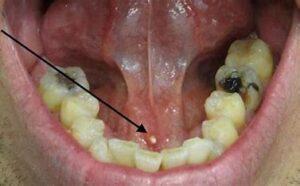What is it?
Salivary gland stones, also known as sialoliths or salivary calculi, are calcified deposits that form within the ducts of the salivary glands. These stones can block the flow of saliva from the gland into the mouth, leading to symptoms such as pain, swelling, and difficulty eating or opening the mouth.
Here are some key points about salivary gland stones:
- Formation: Salivary gland stones typically form when minerals in saliva (such as calcium and phosphate) crystallize and accumulate within the ducts of the salivary glands. The exact cause of stone formation is not always clear but may be related to factors such as dehydration, reduced salivary flow, bacterial infection, or structural abnormalities of the salivary ducts.
- Location: Salivary gland stones most commonly occur in the ducts of the submandibular glands, which are located beneath the floor of the mouth. However, they can also affect the ducts of the parotid glands (located in the cheeks) or the sublingual glands (located beneath the tongue).
- Symptoms: The presence of a salivary gland stone can cause symptoms such as pain and swelling in the affected gland, particularly during meals when saliva production increases. Other symptoms may include difficulty opening the mouth, dry mouth, foul-tasting saliva, or recurrent infections (sialadenitis) due to obstruction of the gland’s duct.
- Diagnosis: Diagnosis of salivary gland stones typically involves a combination of medical history, physical examination, and imaging studies. Imaging tests such as ultrasound, CT scan, or sialography (a specialized X-ray procedure) may be used to visualize the location and size of the stone within the salivary duct.
- Treatment: Treatment of salivary gland stones depends on the size and location of the stone, as well as the severity of symptoms. Small stones may be managed conservatively with measures such as hydration, warm compresses, sour candies, or massage to stimulate saliva flow and facilitate stone expulsion. Larger stones or stones causing persistent symptoms may require more invasive treatment, such as manual expression of the stone, sialendoscopy (insertion of a tiny endoscope into the duct to visualize and remove the stone), or surgical removal of the affected gland (sialadenectomy).
- Prevention: To prevent the formation of salivary gland stones, it is important to maintain good oral hygiene, stay well-hydrated, and avoid risk factors such as dehydration, reduced salivary flow, or poor dietary habits that may contribute to stone formation. Regular dental check-ups and prompt treatment of any underlying conditions that may predispose to stone formation can also help prevent recurrence.
In summary, salivary gland stones are calcified deposits that form within the ducts of the salivary glands, leading to symptoms such as pain, swelling, and difficulty eating. Treatment options vary depending on the size and location of the stone but may include conservative measures, minimally invasive procedures, or surgical intervention to alleviate symptoms and prevent complications.

